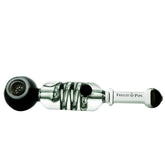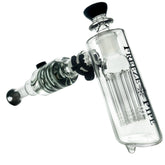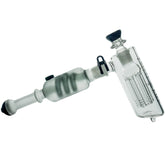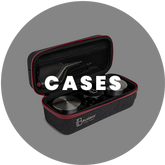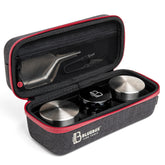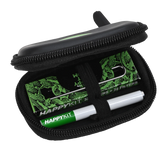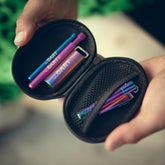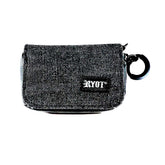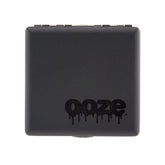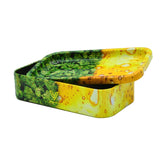Cases
-
Vendor:Happy Kit
Happy Kit - Deluxe - Gray
Introducing the Happy Kit, a must-have companion for enthusiasts. It takes its place as the ultimate travel accessory, ensuring that you're always well-prepared. Bid farewell to the frustration of misplacing your essentials or dealing with accidental breakages. With its odor-resistant and exceptionally durable casing,...- $19.99
$24.99- $19.99
- Unit price
- per
Save $5.00- Gray
- Pink
- Black
-
Vendor:Blue Bus fine tools
BULLDOG Smell Proof Stash Case - Yellow
Our Smell Proof Stash Bag is created to provide you with everything you need for a hassle-free session. Bulldog includes: Tiger Metal cone tray Metal packing stick Cleaning brush Mini scissors BUNKER Stainless steel jar 160ml X2 2.5 Inch Aluminum grinder On-the-Go Organizer Our...- $79.99
$79.90- $79.99
- Unit price
- per
Save $-0.09- Black
- Yellow
- Red
-
Vendor:Smoke Drop
Hard Clamshell Pipe Case
Introducing the Hard Clamshell Pipe Case, designed to provide ultimate protection for your pipe while you're on the move. Whether you're traveling or simply heading out for the day, this case ensures your pipe stays safe and secure. Features: Hard shell outer for protection...- From $6.99
- From $6.99
- Unit price
- per
-
Vendor:Happy Kit
Happy Kit - Mini - Gray
Introducing the Mini Happy Kit, your pocket-sized partner designed for enthusiasts on the go. This little wonder embodies the spirit of the Ultimate Travel Kit, giving you the confidence of being prepared wherever you venture. No more worrying about misplacing your essentials or fragile...- $9.99
- $9.99
- Unit price
- per
- Gray
- Black
-
Vendor:Dart
Dart One Hitter Carrying Case
Dart One Hitter Carrying Case Our carry case is perfect for holding your DARTs, canisters, lighters and/or any other essentials. Keep all your goods in one place and ready with easy access with our biggest carry option with smell-resistant zipper.- $15.99
- $15.99
- Unit price
- per
-
Vendor:Ryot
RYOT Smell Safe Krypto Kit - Black
The ultimate pocketable case for vapes and glass, the RYOT SmellSafe Krypto-Kit in Black has been popular among smokers since its release in 2000. Today, the Krypto-Kit also features carbon fiber technology for absorbing unwanted odors.- $27.99
$0.00- $27.99
- Unit price
- per
Save $-27.99- Black
- Camo
- Natural
- Olive
-
-
Vendor:East West Trading Corp. LTD
5-CONE HOLDER PLASTIC BIODEGRADABLE CASE - Black
- $5.99
$0.00- $5.99
- Unit price
- per
Save $-5.99- Black
- White
- Green
- Red
-
Vendor:Ryot
Ryot HardCase Smell Proof Case - Black
Attach it to your pack or throw it in your bag, the RYOT SmellSafe Small HardCase in Camo offers custom storage for delicate and small accessories with a hard case, internal padding, and straps.Worried about odors? This weatherproof case also comes with smell-resistant carbon...- $19.99
$0.00- $19.99
- Unit price
- per
Save $-19.99- Camo
- Tan
- Black
- Olive
-
Vendor:Puffcase
PUFFCASE JOINT & LIGHTER HOLDER - White
- $12.99
$0.00- $12.99
- Unit price
- per
Save $-12.99- White
- Black
-
Vendor:V Syndicate
Oil and Bud Syndicase 2.0
Whether you want to smoke it or dab it, the new and improved Oil and Bud Syndicase 2.0 is exactly what you need to travel with your stash. We have taken our durable and smell proof stash boxes and added waterproof technology, and a curved lid...- $9.99
- $9.99
- Unit price
- per
-
Vendor:Ryot
RYOT 4.0L Smell Proof Safe Case - Black
Introducing the RYOT 4.0L Safe Case Large Carbon Series with SmellSafe and Lockable Technology in Black with RYOT Lock: the ultimate odor-protected carrying case. This durable case also features a moisture seal zipper, weather-proof fabric, and carbon lining. With an integrated rolling tray and...- $94.99
$0.00- $94.99
- Unit price
- per
Save $-94.99- Black
- Olive
- Camo
-
Vendor:East West Trading Corp. LTD
3-CONE HOLDER PLASTIC BIODEGRADABLE CASE - Red
- $4.99
$0.00- $4.99
- Unit price
- per
Save $-4.99- Red
- Green
- Black
- Blue
-
Vendor:RAW
RAW Three Tree Case
RAW Three Tree Case Introducing the RAW Three Tree Case, the ultimate solution for pre-roll enthusiasts who value functionality, style, and eco-friendliness. This triple pre-roll case is designed to keep your favorite pre-rolls safe, secure, and ready for any occasion. Key Features: Triple Capacity:...- $29.99
- $29.99
- Unit price
- per
-
Vendor:Fonz
FONZ - Grinder & Storage Combo - Jellybean
FONZ - Grinder & Storage Combo When people ask for candy I'm eating, I give them the ones I don't like... Don't like the green skittles? Then Jellybean is the FONZ for you!- $49.99
- $49.99
- Unit price
- per


